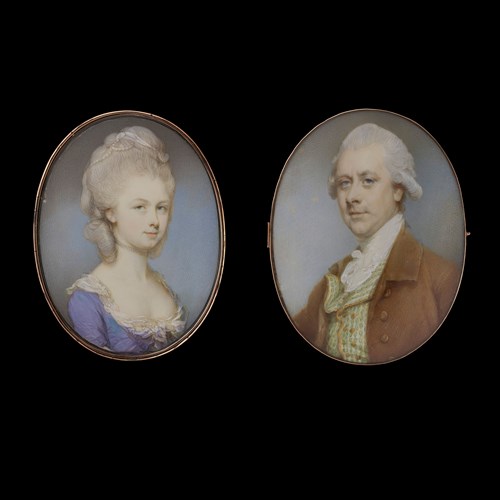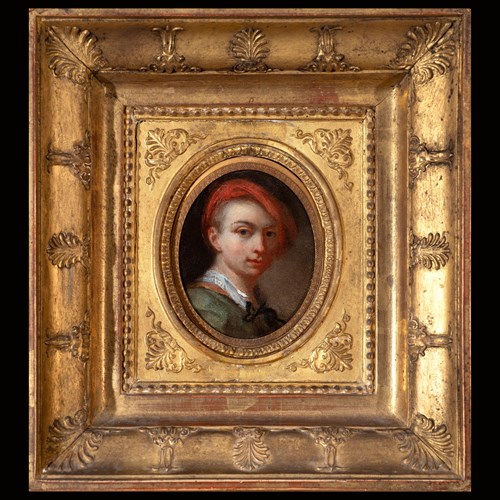Marketplace
Portrait miniature of Walter Bocland (Bockland) of Standlynch (1619-70)
DAVID DES GRANGES
Portrait miniature of Walter Bocland (Bockland) of Standlynch (1619-70)
The Limner Company : Portrait Miniature
Date dated 1657
Medium Watercolour and bodycolour on vellum
Dimension 7 cm (2³/₄ inches)
David des Granges would have been an obvious choice for the portrait of royalist (and recusant)[1] Walter Bocland (also spelt Bockland or Buckland). Fiercely loyal to the royal cause, the artist had travelled with the exiled Charles, Prince of Wales, to Scotland and then to the continent. However, One unnoticed reference to him has been discovered by the scholar Christopher Lennox-Boyd (1941-2012) which places Des Granges back in London around the date of this current portrait. In 'Mercurius Politicus' for 22/9 July 1658: 'There is one David Des Grange that has been known these many years in the art of miniature or limning, by the life, or copying, approved to be none of the worst ... his lodging is, which is at one Mr Palmer's a gunsmith in the Strand, right against the Fountain Tavern'. It is likely, therefore, that Bocland’s portrait was painted at this studio in London.
The Boclands, originally known as ‘de’ Bocland were an ancient family, given lands which by the reign of Henry IV they had lost. The family owned ‘Standlynch’, which is first mentioned in the Domesday Book of 1086. During the Tudor period the Standlynch estate was owned by the Beachamp family followed by the Greene family through the Elizabethan reign; by the 17th Century the Bucklands (or Bocklands) owned Standlynch Manor which was situated beside Standlynch Church and the River Avon. The Church, still part of the estate today, was itself founded in 1146 and rebuilt in 1677 by Walter’s daughter in law, Joan, in memory of her father, Col. John Penruddock who had been ‘beheaded for fighting in the King’s Cause’ by Cromwell prior to the Restoration.
Though Bockland was baptised as an Anglican, the entire family, including his wife, were recusants before the Civil War. Bockland seems to have subsequently falsified his age to prove that he was only 16 in 1640, and therefore not liable to the penalties of recusancy. Unfortunately, he had been described as 18 years of age and upwards on his father’s death. He produced a rather dubious sacrament certificate from Sussex, dated 1641, but it is improbable that he conformed till after the war, when, as a Papist in arms, he might have lost his entire estate. He took the Covenant on 11 July 1645, and in the following year the rector of St. Margaret’s Westminster certified that ‘Mr Walter Bockland, after conference with me and good satisfaction given unto me of his settled conformity to the doctrine and worship of the Church of England, received the sacrament’. Eventually he was allowed to compound for £696, but he was described as a Papist in 1655 at the time of Penruddock’s rising, when there was a suspicious gathering of horsemen at his house. At the Restoration, Bockland, whose mother was first cousin to the Earl of Bristol, was recommended for the order of the Royal Oak, with an estate of £900 p.a..
Bockland was an inactive Member of the Cavalier Parliament, serving on only ten committees, none being of political importance. With good grounds for discontent with the Clarendon administration, he was probably a country Cavalier, though his name does not appear on any list. In his will, dated 1 Oct., he bequeathed £100 to his recusant servant Robert Lincoln, and provided for his burial in his chapel at Standlynch, which with the preceding circumstances suggests that he may have returned on his deathbed to the church of his baptism. Walter’s one surviving son with his wife Helen (daughter of Hubert Hacon of Norwich) was Maurice Bocland (1648-1710), who was MP for Downton in 1690.[2]
[1] Recusancy was the state of those who remained loyal to the Catholic Church and refused to attend Church of England services after the English Reformation. The 1558 Recusancy Acts passed in the reign of Elizabeth I, and temporarily repealed in the Interregnum, remained on the statute books until 1888.
[2] Maurice Bocland made his will on 2 May 1710. The extensive coalmines, lead mines and quarries centred upon Shepton Mallet, Somerset, were settled on trustees, including his ‘nephew’ Thomas Freke*, to pay off his debts and secure £2,200 on his four younger daughters, who were also given the annuities of £800 invested in the Exchequer.
The Boclands, originally known as ‘de’ Bocland were an ancient family, given lands which by the reign of Henry IV they had lost. The family owned ‘Standlynch’, which is first mentioned in the Domesday Book of 1086. During the Tudor period the Standlynch estate was owned by the Beachamp family followed by the Greene family through the Elizabethan reign; by the 17th Century the Bucklands (or Bocklands) owned Standlynch Manor which was situated beside Standlynch Church and the River Avon. The Church, still part of the estate today, was itself founded in 1146 and rebuilt in 1677 by Walter’s daughter in law, Joan, in memory of her father, Col. John Penruddock who had been ‘beheaded for fighting in the King’s Cause’ by Cromwell prior to the Restoration.
Though Bockland was baptised as an Anglican, the entire family, including his wife, were recusants before the Civil War. Bockland seems to have subsequently falsified his age to prove that he was only 16 in 1640, and therefore not liable to the penalties of recusancy. Unfortunately, he had been described as 18 years of age and upwards on his father’s death. He produced a rather dubious sacrament certificate from Sussex, dated 1641, but it is improbable that he conformed till after the war, when, as a Papist in arms, he might have lost his entire estate. He took the Covenant on 11 July 1645, and in the following year the rector of St. Margaret’s Westminster certified that ‘Mr Walter Bockland, after conference with me and good satisfaction given unto me of his settled conformity to the doctrine and worship of the Church of England, received the sacrament’. Eventually he was allowed to compound for £696, but he was described as a Papist in 1655 at the time of Penruddock’s rising, when there was a suspicious gathering of horsemen at his house. At the Restoration, Bockland, whose mother was first cousin to the Earl of Bristol, was recommended for the order of the Royal Oak, with an estate of £900 p.a..
Bockland was an inactive Member of the Cavalier Parliament, serving on only ten committees, none being of political importance. With good grounds for discontent with the Clarendon administration, he was probably a country Cavalier, though his name does not appear on any list. In his will, dated 1 Oct., he bequeathed £100 to his recusant servant Robert Lincoln, and provided for his burial in his chapel at Standlynch, which with the preceding circumstances suggests that he may have returned on his deathbed to the church of his baptism. Walter’s one surviving son with his wife Helen (daughter of Hubert Hacon of Norwich) was Maurice Bocland (1648-1710), who was MP for Downton in 1690.[2]
[1] Recusancy was the state of those who remained loyal to the Catholic Church and refused to attend Church of England services after the English Reformation. The 1558 Recusancy Acts passed in the reign of Elizabeth I, and temporarily repealed in the Interregnum, remained on the statute books until 1888.
[2] Maurice Bocland made his will on 2 May 1710. The extensive coalmines, lead mines and quarries centred upon Shepton Mallet, Somerset, were settled on trustees, including his ‘nephew’ Thomas Freke*, to pay off his debts and secure £2,200 on his four younger daughters, who were also given the annuities of £800 invested in the Exchequer.
Date: dated 1657
Medium: Watercolour and bodycolour on vellum
Signature: signed with initials DDG
Dimension: 7 cm (2³/₄ inches)
Provenance: Private Collection, UK
More artworks from the Gallery


 of Standlynch (1619-70)_T638912317218987991.JPG?width=2000&height=2000&mode=max&scale=both&qlt=90)




, wearing white dress, the sleeves with blue ribbon trim, matching blue rib_T638780704211238651.JPG?width=500&height=500&mode=pad&scale=both&qlt=90&format=jpg)

